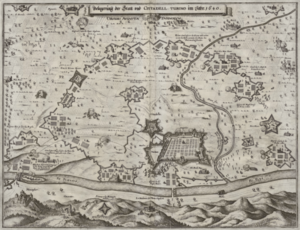Siege of Turin (1640) facts for kids
Quick facts for kids Siege of Turin (1640) |
|||||||
|---|---|---|---|---|---|---|---|
| Part of the Piedmontese Civil War | |||||||
 Siege of Turin (engraving by M. Merian/C. Cappi) |
|||||||
|
|||||||
| Belligerents | |||||||
| Commanders and leaders | |||||||
| Strength | |||||||
| 10,000 | 12,000 (Turin) 15,000 (Relief force) |
||||||
| Casualties and losses | |||||||
| 4,000 | 9,000 | ||||||
The 1640 siege of Turin was a big military event that happened from May 22 to September 20, 1640. A siege is when an army surrounds a city or fort to try and take it over. This siege was part of two different wars happening at the same time: the Franco-Spanish War (1635–59) and the Piedmontese Civil War.
The city of Turin is in what is now northwest Italy. During the siege, Thomas Francis, Prince of Carignano and his group (called a faction) had taken control of Turin. However, French soldiers who supported the Regent (a ruler who governs for a young king or queen) Christine Marie of France were still holding out in the city's strong fort, called the citadel.
A French and Piedmontese army, led by Henri de Lorraine, count of Harcourt and Henri de la Tour d'Auvergne, Vicomte de Turenne, then surrounded Prince Thomas's forces inside the city. But then, a Spanish army led by Diego Felipez de Guzmán, Marquis of Leganés arrived and surrounded the French army! This created a very unusual situation known as a triple siege. It meant the Spanish army surrounded the French army, who surrounded Prince Thomas's Piedmontese forces, who surrounded the French soldiers in the citadel.
In the end, the French side won. Prince Thomas agreed to surrender and was allowed to leave with his troops. This left Turin under French control.
Contents
Why the Siege Happened
Control of Turin and the Citadel
In 1639, Thomas Francis, Prince of Carignano and his supporters took over the city of Turin. But French soldiers, who were on the side of the Regent Christine Marie of France, still held the strong fort, or citadel. Usually, a city couldn't be held if an enemy controlled its citadel. But Prince Thomas's forces built walls and barriers to keep the French trapped inside the citadel. They spent the winter of 1639–40 in a tense standoff.
French Army Arrives
On May 10, 1640, the French army, led by Henri de Lorraine, count of Harcourt and Henri de La Tour d'Auvergne, Viscount of Turenne, began to surround the city. This was the start of the siege. The French army had about 6,000 foot soldiers and 3,500 cavalry (soldiers on horseback). They also had help from 3,500 Piedmontese soldiers who supported the Regent.
The Siege Begins
Surrounding the City
The French army first pushed back the defenders' small outposts outside Turin. Then, they built their "lines of investment." These were walls and trenches that completely surrounded the city. This made it hard for anyone to get in or out. On May 22, the French began firing their cannons at Turin.
The Spanish Arrive
On May 31, a Spanish army showed up. This army was led by Diego Felipez de Guzmán, Marquis of Leganés, who was the governor of Milan. Even though the Spanish army had more soldiers than the French, Leganés didn't dare to attack Harcourt's lines directly. Instead, he started to build his own trenches and surround the French army.
A Four-Layered Conflict
This created a very complex situation. It became a four-layered siege:
- French soldiers were still inside the citadel, being attacked by Prince Thomas's forces.
- Prince Thomas's forces were inside Turin, being surrounded by Harcourt's French army.
- Harcourt's French army was outside Turin, being surrounded by Leganés's Spanish army.
For weeks, Prince Thomas's forces in Turin still held some areas outside the city. This allowed them to get supplies and communicate with the Spanish army. Messages were even sent by putting them inside cannonballs and firing them over the French lines! But by late July, Harcourt's army captured these last outposts.
Food Shortages and Attempts to Escape
After Prince Thomas lost his outside posts, food became scarce for the people and soldiers inside Turin. Horses ran out of food first. Prince Thomas tried twice, on July 23 and 31, to break out with his cavalry. But both attempts failed. Harcourt's army was never completely cut off by the Spanish, and they could still communicate with the French soldiers in the citadel.
The Surrender
Negotiations Begin
Eventually, Turin had to consider giving up. Prince Thomas had been talking with the French and the Regent throughout the siege. He started serious negotiations with Harcourt. Harcourt made an agreement that went against his orders from Paris. Some historians say he didn't know about the new orders. Others say he wanted to win the glory of victory himself before Mazarin, a powerful agent of Cardinal Richelieu, arrived with new instructions.
Terms of Surrender
Whatever the reason, Harcourt agreed to a ceasefire on September 16. On September 20, the official surrender agreement, called a capitulation, was signed. Prince Thomas was given honorable terms. This meant he and his troops were allowed to march out of Turin with their weapons and flags. On September 24, Prince Thomas and his soldiers left Turin and went to Ivrea. This left Turin under French control.

